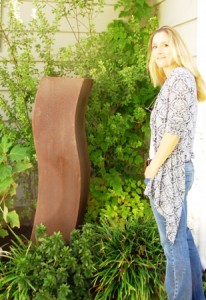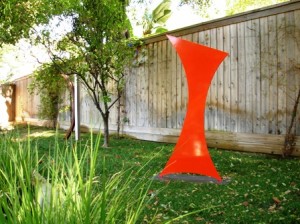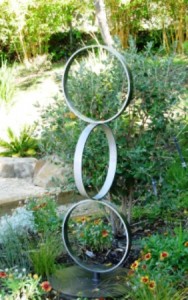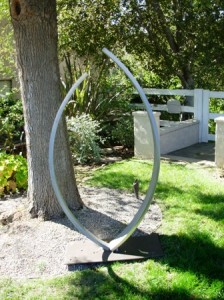Art in the garden
January 5th, 2009
 Here’s my January 2009 “In the Garden” column for 805 Living magazine, featuring artist and designer Jennifer Gilbert Asher and her beautiful sculpture.
Here’s my January 2009 “In the Garden” column for 805 Living magazine, featuring artist and designer Jennifer Gilbert Asher and her beautiful sculpture.
GARDENS AS GALLERIES: Choose and place ornamentation with a thoughtful eye toward your garden’s overall design.
Why do artful objects – such as sculpture, salvaged architectural fragments or even a birdbath – make such an impression in the garden?
Like adding jewelry to a little black dress, or a few bright pillows to a tired sofa, artwork, sculpture and ornamentation can take any garden from ordinary to extraordinary. Well-placed art adds to, rather than detracts from, the overall composition. In the winter, when the garden is quieter, artwork often takes center stage.
 “Even though sculpture is a four-season element in the landscape, it becomes the star of the show when everything else is going dormant,” says Jennifer Gilbert Asher, principal of Woodland Hills-based Chilmark Gardens. [see Jennifer, right, with “Curvas,” placed in her own garden.]
“Even though sculpture is a four-season element in the landscape, it becomes the star of the show when everything else is going dormant,” says Jennifer Gilbert Asher, principal of Woodland Hills-based Chilmark Gardens. [see Jennifer, right, with “Curvas,” placed in her own garden.]
Precious objects, displayed side-by-side with foliage and flower – or partially hidden among the stems and branches of a favorite plant – give a garden its personality. They also communicate volumes about its owner’s taste and style.
“I place sculpture not just to complement the garden, but to transform it,” Asher says. “A captivating sculpture can spike curiosity and provoke thought. It can be playful or energetic; meditative or even sensual.”
Asher was inspired to design a collection of bold, modern pieces after she had trouble finding affordable artwork for her client’s landscapes. “I was shocked at the lack of accessible fine art for the garden. I heard the same thing from other designers, all over the country. You shouldn’t have to be a millionaire to transform your landscape into an outdoor art gallery,” she says.
 She teamed up with Los Angeles entrepreneur Karen Neill Tarnowski last fall to launch TerraSculpture, an online art gallery and sculpture studio. Asher design and create abstract, graphic forms in stainless, weathered and powder-coated steel. TerraSculpture uses durable, outdoor-friendly material such as 11-gauge steel; finishes vary from brushed stainless to eye-popping primary colors. [at left: “Leap”]
She teamed up with Los Angeles entrepreneur Karen Neill Tarnowski last fall to launch TerraSculpture, an online art gallery and sculpture studio. Asher design and create abstract, graphic forms in stainless, weathered and powder-coated steel. TerraSculpture uses durable, outdoor-friendly material such as 11-gauge steel; finishes vary from brushed stainless to eye-popping primary colors. [at left: “Leap”]
With names like “Embrace” and “Closer,” many of the pieces evoke human emotions. And unlike the type of sculpture you’d see in public parks or museums, which is far too large for the domestic landscape, TerraSculpture’s designs range from 4-1/2-feet-tall to 6-1/2-feet-tall. (For customers whose homeowner-association covenants restrict anything that appears above backyard fences or walls, these dimensions offer added benefits.)
ART FOR EVERYONE
While there is no right or wrong in the highly subjective endeavor of choosing artwork for your garden, there are several general tenets that are useful to follow:
Scale and proportion:
 Think of scale as the “heft” of the artwork — including its material, shape and form — especially as your garden relates to your home and the greater environment. “You should take into account not only the immediate surroundings, but also the background,” Asher says. “A mountain, an ocean view, the sky, looming majestic trees, or even a fence or wall – all these elements should be considered.”
Think of scale as the “heft” of the artwork — including its material, shape and form — especially as your garden relates to your home and the greater environment. “You should take into account not only the immediate surroundings, but also the background,” Asher says. “A mountain, an ocean view, the sky, looming majestic trees, or even a fence or wall – all these elements should be considered.”
Proportion is a close relative to scale because a garden is a three-dimensional space seen from many points of view. “What intrigues me about sculpture is that we’re juxtaposing something man-made into a completely organic environment,” Asher adds. “I love the contrast.” [“Sisters,” right]
Placement and balance:
Use sculpture to dramatize and emphasize your landscape’s best focal points.
And be intentional about placement choice, Asher says. “To me, the most comfortable place for the focal point is always at eye level. Stand back and study the placement from where most people will be enjoying the art. Perhaps it’s from inside the home, or sitting poolside, or from a front entry.”
While it may seems just fine to situate a piece of artwork at the base of your patio steps, perhaps there’s a better place for it. As you stand in the garden, use your eye as a guide. What area earns your notice? Is it a bare spot beneath the canopy of the sycamore tree? Or is it a sweeping lawn enclosed by an evergreen hedge? These may be the ideal venues for artwork or sculpture.
Asher likes sculpture that features a “window” element, emphasizing the see-through quality of her art. “Looking through a frame is almost magnetic,” she says. “You want to see what’s inside, through it, and beyond – to the simple, harmonious beauty of nature itself.”
The final edit:
 Adding artwork to the landscape also calls for a dose of restraint. Take a walk through your garden and eliminate the clutter and anything kitschy. Strive to add extraordinary pieces to your garden and remove objects that don’t distinguish themselves.
Adding artwork to the landscape also calls for a dose of restraint. Take a walk through your garden and eliminate the clutter and anything kitschy. Strive to add extraordinary pieces to your garden and remove objects that don’t distinguish themselves.
There is a notable difference between decorative garden accessories and outdoor sculpture, Asher explains. She clearly prefers the latter. “Enjoying art should be part of our daily life. Here in Southern California, we spend as much time outdoors as we spend inside, so I think people need to start looking to their outdoor environments as an extension of their home – without walls, but with more artful possibilities.”
Well-placed sculpture will enhance your garden’s beauty and reflect your personal style. Give your garden an air of sophistication, a sense of harmony and a touch of restraint. “Sculpture becomes almost personified,” Asher says. “It’s like a friend that’s always standing there greeting you.” [“Embrace,” left]









January 6th, 2009 at 6:01 pm
Beautifully written article, Debra! Your writing and creativity are as artful as any piece of sculpture! Bravo!
January 6th, 2009 at 8:47 pm
These sculptures are amazing. Thank you for making this artwork available to homeowners.
January 8th, 2009 at 11:24 pm
Thanks for sharing Jennifer Asher’s exquisite and accessible sculpture. I enjoyed the insight on evaluating garden art and it’s placement.
Good stuff.
Shirley
January 12th, 2009 at 11:42 am
Great article about Terra Sculpture, Debra. Well written! Thanks so much!
Karen Neill Tarnowski
January 17th, 2009 at 10:47 am
[…] introduced me to several Southern California garden creators, including Shirley (Edenmaker), Jennifer Gilbert Asher of TerraSculpture (I’ve recently written about her work), and Laura Morton of Laura Morton […]
March 6th, 2009 at 9:49 am
I love these too…I featured them on my site as well (jennifer mentioned you and your site which is why I am here). Great site…I look forward to reading a bit more… make sure you come by studio ‘g’ – I think you will enjoy it.
rochelle greayer’s last blog post..Pigeons
March 18th, 2009 at 1:12 pm
[…] Great start with a beautifully written article in 805 Living by garden writer, blogger and author Debra Prinzing who’s new book Stylish Sheds and Elegant Hideaways is a must read! https://www.slowflowerspodcast.com/2009/01/05/art-in-the-garden/#more-1555. […]